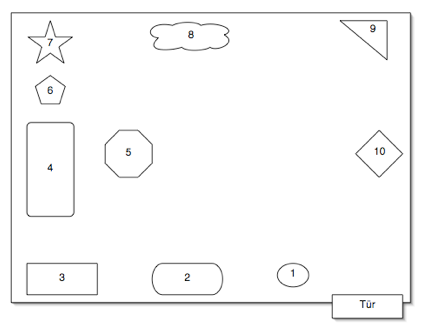Journey method
Wichtig für eine brauchbare Route ist, dass sie an vertrauten Orten verläuft. Für erste Übungen eignen sich daher die eigene Wohnung oder das eigene Zimmer. Um die Route zu strukturieren, solltest du jeden Raum nach einem gleichen Schema durchlaufen, zum Beispiel immer von der Tür aus im Uhrzeigersinn, dann von unten nach oben, immer von links nach rechts und von vorn nach hinten.

- Bookcase
- Glass cabinet
- Aquarium
- Sofa
- Coffee table
- Lamp
- Flower
- Picture
- Stereo system
- Television
- Try to avoid double items, for example the basin in the bathroom and the basin in the kitchen. You should rather focus on details: Use the leakage in the bathroom and the tap in the kitchen.
- Try to avoid items ocurring necessarily in each room like light switches, doors, sockets, radiators, and so on.
- Keep the the same walking direction in each room.
- Memorise the same amount of journey points in each room. It is helpful to use ten points. This makes it easier to fill the gap if you miss some points at some stages.
- You should use journey points which are situated permanently in the room. Clothes, for example, lie around everywhere and are not a reliable journey point.
- First you have to decide if you want to attach different pictures to the journey points at a later stage or if you want to keep the pictures permanently on the journey. To reuse a journey it will take up to one week to delete old pictures and attach new pictures to the journey points according to the intensity of the pictures. It also depends on how often you repeat the procedure. Therefore, memory champions usually have several thousand journey points. Under "My memocamp" you can also store several journeys.
Die Routenpunkte dienen nun als Anknüpfungspunkt, mentaler Kleiderhacken oder auch mentaler Briefkasten und sind eigentlich nur für die richtige Reihenfolge wichtig. Die Routenpunkte helfen dir nun ganz verschiedene Dinge zu merken. Möchtest du dir eine Einkaufsliste mit Müsli, Pizza, Cola, Bananen, Milch etc. einprägen, verknüpfe die einzelnen Punkte der Liste mit deinen Routenpunkten. Das Müsli mit dem ersten Punkt, dem Bücherregal. Da wir es nicht einfach da hinlegen können und hoffen, uns daran zu erinnern, das wäre zu langweilig, müssen wir eine kleine Geschichte daraus machen. Mit viel Action, Emotion und Übertreibung.
Here is one example: cereals and shelf: The cereals are huge, the raisins are not dried yet and they are everywhere in my books. The grains are fighting with the oatmeal. I try to calm them down to get them back into the bag. You will memorise this image. For sure! And now let's come to the 2nd point - Pizza and Showcase: I display the tastiest pizza in the show case. Spotlights are used for show case lighting. Unfortunately, the pizza starts to feel bored. The salami slices start coiling up to sleep. The cheese becomes brown due to the spotlights. And now let's come to the 3rd Point - Coke and Aquarium: The aquarium water becomes brown. The fish swim much faster than usual due to a high dose of caffeine. Cola bottles are the new attraction in the basin.
When I will go shopping later, I only need to mentally walk the journey and I can be sure that I will not forget anything. The advantage of this system is that 100 items can be memorised as easily as 10 items.
Es ist wichtig, nach und nach immer mehr Routen anzulegen. Es gibt die verschiedensten Möglichkeiten Routen zu bauen. Einige Beispiele: Auf dem Weg zur Arbeit, im Garten, im Urlaub, bei Freunden und Verwandten, im Park ja sogar in Computerspielen. Je mehr Routenpunkte du hast desto mehr kannst du dir merken. Inzwischen habe ich mehrere Routen in meinem Kopf abgelegt, die insgesamt mehr als 4.000 Routenpunkte aufweisen.
For the beginning, I have created two journeys. A body journey, which is very handy, because you can always keep the journey with you and a Samplehousejourney. The journey contains 52 points. In this way, you can also memorise an entire deck of cards.
 Menü
Menü